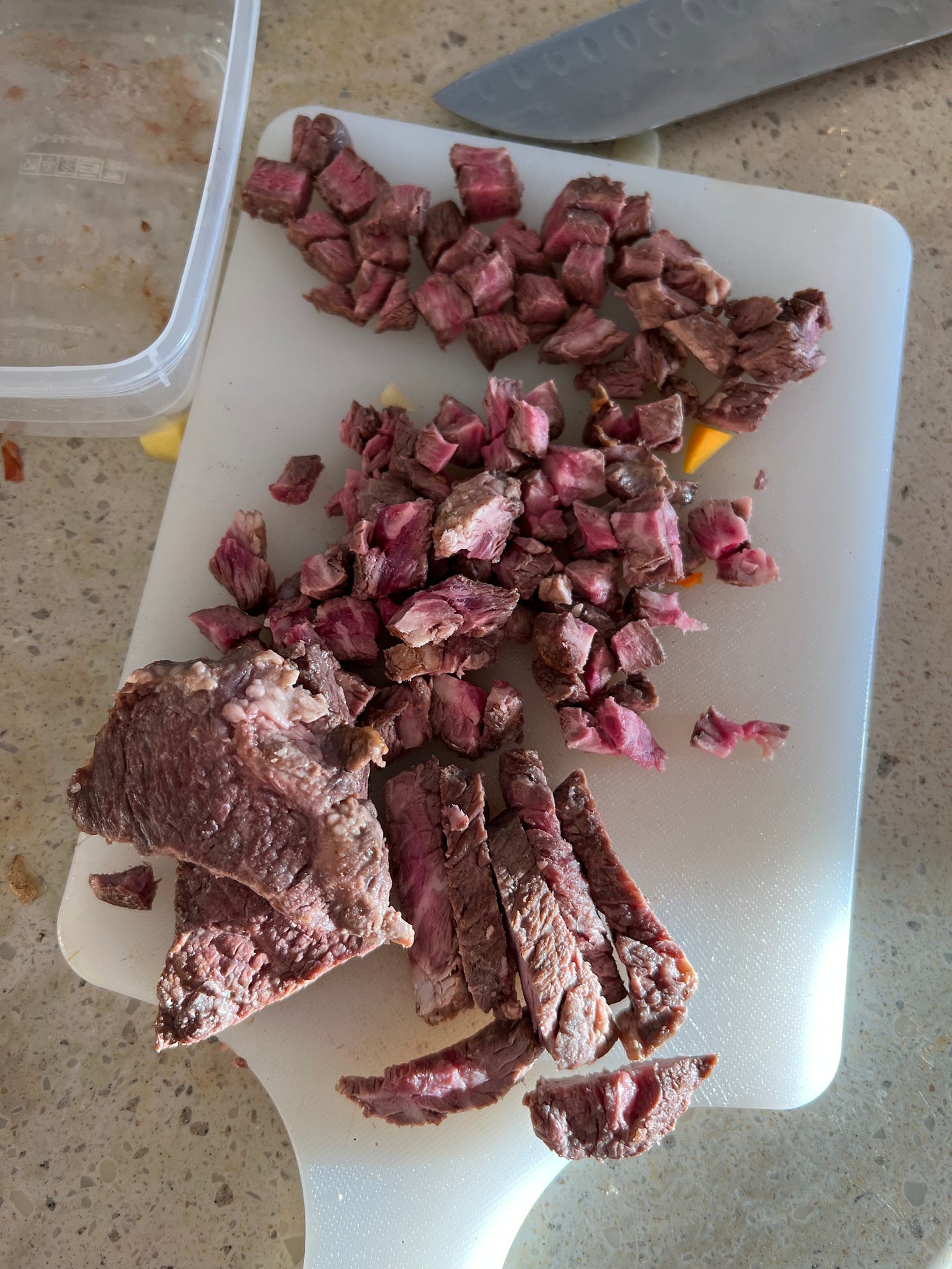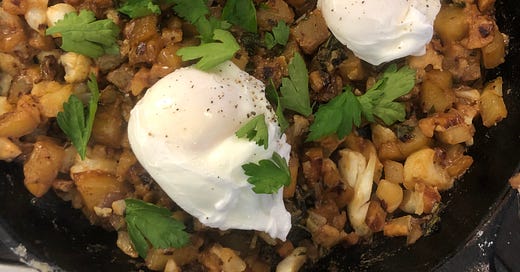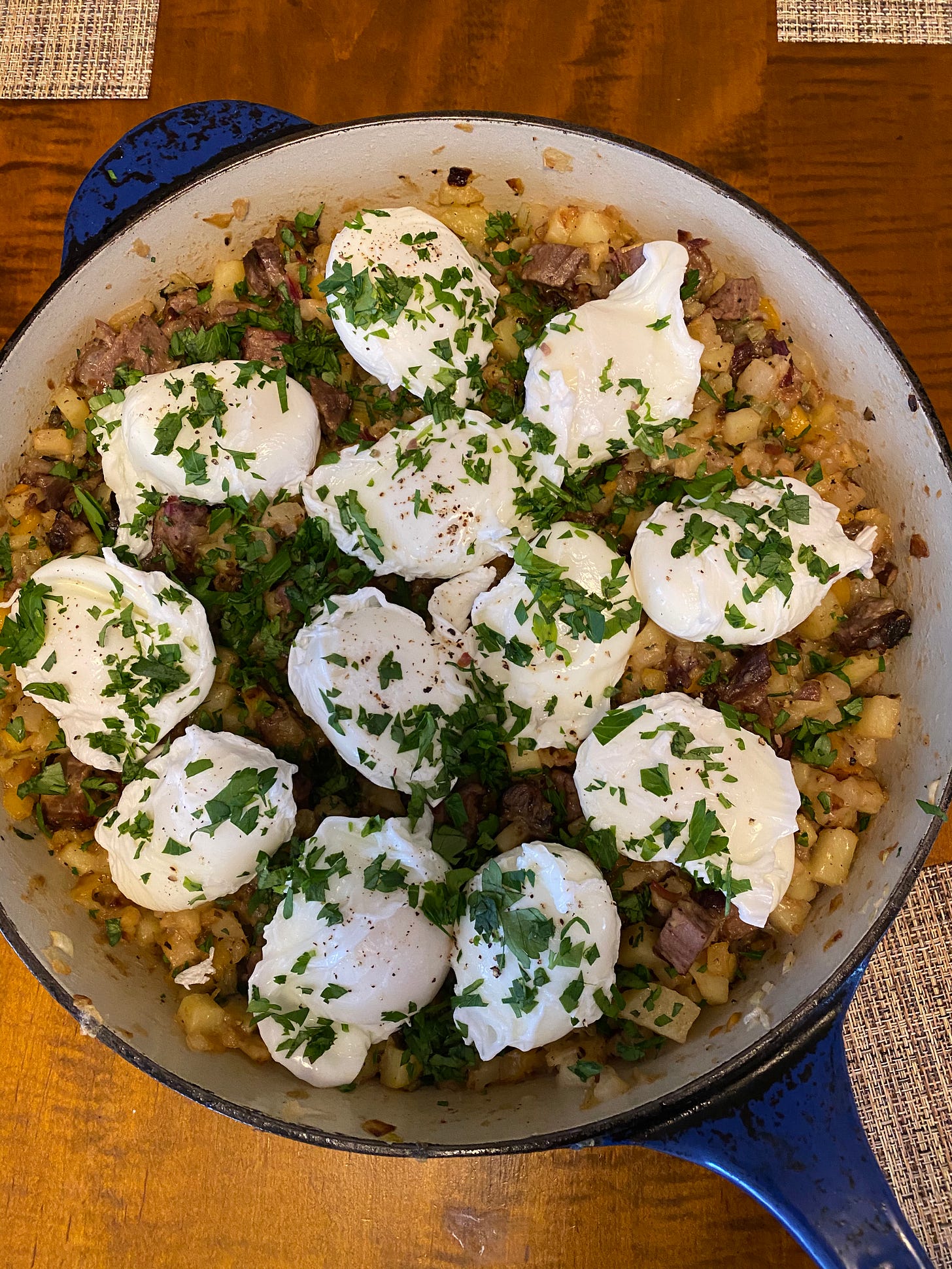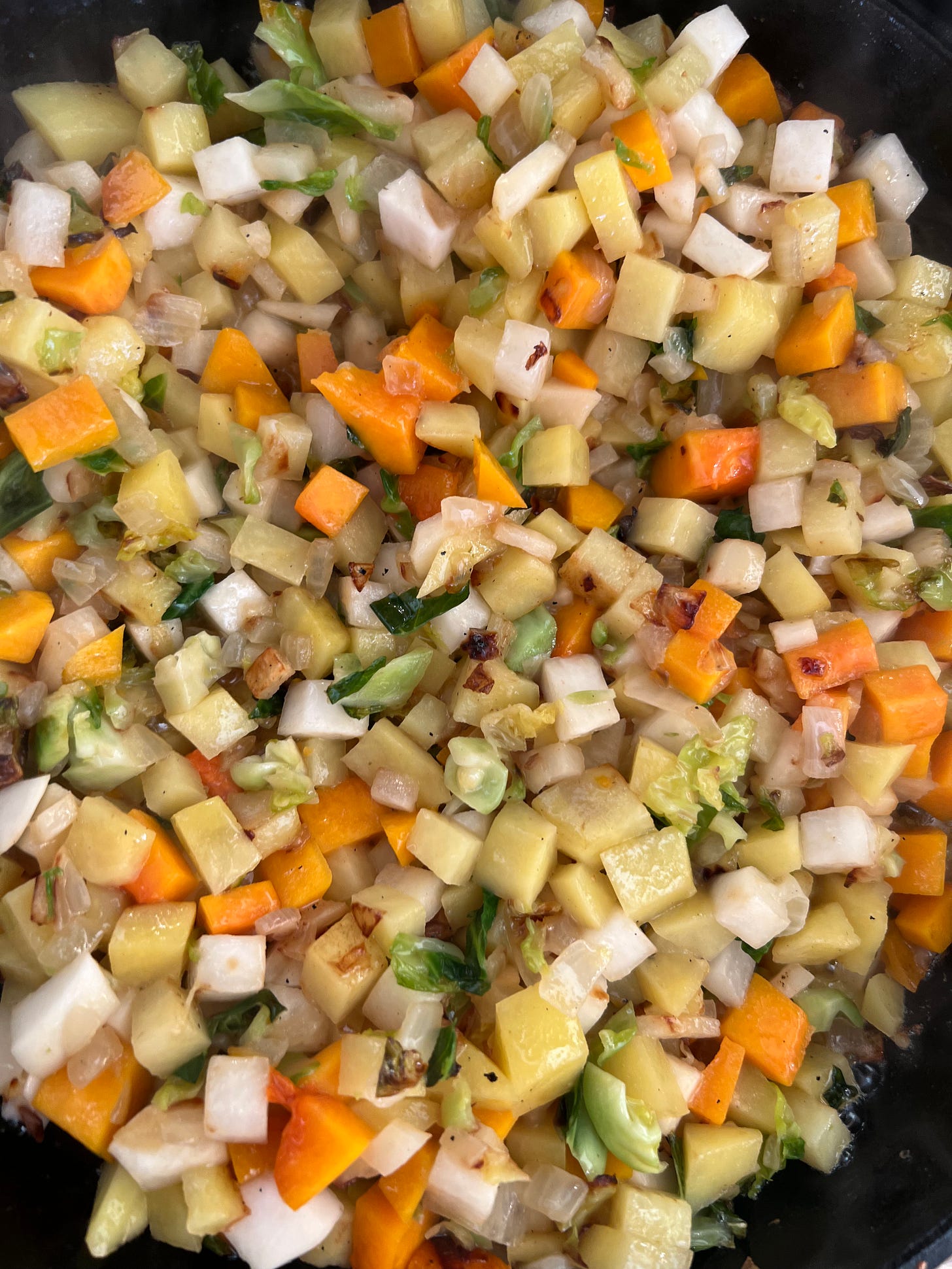Issue #75: "Oh, You Want Hash!"
A Futuristic Dining Experience in Miami, What's Burning, and a "Recipe" for Hash
One of the most interesting projects I’ve worked on in recent years is a mixed-reality, art-and-food experience called Aerobanquets RMX by Italian artist Mattia Casalegno. Inspired by Marinetti’s Futurist Cookbook (which I studied in graduate school), Aerobanquets takes you on a fantastical journey that plays with your senses while you move and eat your way through imagined, interactive scenes. One of the last things I did at the James Beard Foundation was install the piece at the Beard House for a sold-out, three-month run. Since leaving JBF, I’ve teamed up with Mattia, the award winning restaurateur-chef duo Roni Mazumdar and Chintan Pandya (Dhamaka, Semma, Adda, and Masalawala) and executive producer Tony Mayes to take Aerobanquets and similar projects global. Our first large-scale production of Aerobanquets is being presented at Superblue (a prestigious immersive art gallery) by Meta Open Arts during Miami Art Week, November 28 thru December. 4. Learn more and buy tickets.
If you prefer more…um…traditional media, please listen to the latest episodes of my What’s Burning podcast, which feature American-chef-turned-Basque-brewer Kevin Patricio and Italian educator and entrepreneur Gabriella Ganugi.
Last issue I offered you a recipe for Jacques Pépin’s Fromage Fort, a great way to use up old cheese. To set the scene, I discussed several dishes I love for their capacity to incorporate many things you might have in your fridge that are asking to be eaten. Hash is one of my favorites. And it is a crowd pleaser.
I make hash after Thanksgiving with leftover turkey. We usually celebrate Thanksgiving in Maine, where I’ve also made hash with leftover lobster. (Maine is one of the few places where “leftover lobster” is commonplace.) I take leftover steak home from restaurants and make hash from that. I’ll bring half a NY-style corned beef or pastrami sandwich home to make corned beef or pastrami hash. I’ve hashed spare ribs and porchetta. By incorporating so many vegetables, hash doesn’t require much meat, which is another thing I like about it. I keep a Ziploc bag in the freezer to gather meaty odds and ends that I save until I have enough to hash.
Well, I used to do that, before we got Milo. Now I have to fight Nate for any leftover meat, which he prefers to chop up as a topping for her kibble. Nate says he does it because he loves her. I think he does it so she will love him (as if those two could be any closer). Nate really likes my hash, too, but in this, as in most things, Milo wins.
(Milo, cover your ears.) In fact, hash doesn’t need any meat at all.
Although I will provide you a recipe for hash below, I never use one because I never have the same things lying around twice. Hash is really just meant to be a chopped-up mishmash of stuff. It used to be more common. For some reason it has a gained a bad reputation. (Carol, our proofreader, suggests the unappetizing canned hash served at diners may be to blame.) Some people approach has skeptically. But I can say without question that everyone I have ever served my hash to loves it. I usually make in the morning, sometimes before coffee, so I never prep all of my ingredients before starting. I don’t even necessarily look to see what I’ve got to use. I just put a pan on the stove and start pulling things out of the fridge to start chopping. (Don’t get me wrong, hash is good for dinner, too.)
La Technique
Here’s an honest description of my technique. I heat a large cast-iron frying pan over medium-high heat and add 3 or 4 tablespoons of fat, usually some rendered bacon fat, some butter, maybe some olive oil. You could use all of one fat, especially butter, or a combination of fats, including duck fat, chicken schmaltz, or oil. While the fat melts and heats, I finely dice a medium to large onion and add it to the pan. If I have old shriveled scallions or leeks I chop them and throw them in, too.
Then I work prepping the ingredients in order from those that require the longest cooking time to those that require the shortest, tossing them in as they are ready, stirring and seasoning all the while. Here’s a rough order I would follow, though I probably wouldn’t have all of these in any given hash, just three or four for five: celery root, carrots, celery, turnips, rutabaga, potatoes (crucial imho), cabbage, kohlrabi, daikon, sweet peppers, butternut squash, kale, Swiss chard stems, fennel, Brussels sprouts, broccoli, cauliflower, green beans, Swiss chard leaves, fresh corn kernels, spinach. Of course, if any of your vegetables are already cooked, you can chop and add them toward the end with the meat. If you like sage, thyme, or other herbs, they go in now, along with plenty of salt and freshly ground pepper.
If you add beets, raw (at the beginning) or cooked (at the end), they bleed, making the whole thing a pinkish red. This is actually a classic American version known as Red Velvet Flannel Hash, which I think was popular long before Red Velvet cake. (Revised 11/2/22 Thanks to a close reader who noted the Yankee hash was flannel, not velvet. I’ve got my fabrics wrong.)
Once all the vegetables are added and the whole mess has been sautéed long enough that everything is almost cooked through, I add my finely diced, cooked meat and cook it a little more. As I said above, just about any cut of cooked beef is good, as is duck, lamb, veal, turkey, and chicken. Tough meat is okay because you are cutting it into small pieces. I sometimes add cooked bacon, sausages, and other charcuterie, too. (If using seafood, like lobster, add it later.) Just cut it all into small dice, the size of the veggies. You add this at the end so you don’t overcook it too much.

Next, I add a heaping tablespoon of flour (you can use a gluten free substitute) and stir it around to distribute, blend with the fat, and cook it some to make a kind of roux. Then I add some milk or cream (you can use stock or even water), to bind it all and cook it some more to make sure the starch in the flour has gelatinized. This is a trick my friend Kerri showed me when I was visiting her one time in Kansas. (She now lives in Washington State, where I presume she still makes hash.)
Push the hash around to cover the bottom of the pan, but don’t flatten the top because the hills and valleys will brown nicely in the oven. It’s likely the hash will stick on the bottom, or at least a residue will and it might even burn a little. This is not a bad thing. I use a wooden spoon to scrape the bottom of the pan and mix it all in. It will loosen as it finished cooking and sits, and a little char adds flavor. You can stop cooking your hash now and wait until just before your guests arrive to finish.
To serve, set the pan in a preheated 400°F. oven to warm the hash through while you poach some eggs for the top. (See my poaching technique in Issue #12.) If you can’t master poached eggs, fry them sunny side up, instead. If things get delayed, turn the oven down to 200°F. and let the hash sit until ready to serve. It won’t dry out. Arrange the eggs on top. Sprinkle each with a little salt and pepper, then scatter some chopped parsley on the whole shebang and serve to the delight of your guest.
What’s with the Title?
Here’s the story behind the title of this newsletter. When I was in high school, our biology class took a marine biology trip to Jamaica. We stayed on a Hoftsra University campus and learned to SCUBA dive to catch and catalogue hundreds of varieties of sea life, whose Latin names we had to memorize before we set them free again back in the ocean. It was an amazing experience.
Of course, there were excursions to various towns. On one such trip I was walking around with my friend Oded and we were constantly being harassed by young kids who began by trying to sell us Chinese paper spiral toys they called “yo-yos” and then invariably ended up offering to sell us us ganja. “Hey you Americans, want a yo-yo?” We ignored them. “How about some ganja?” When we replied that we were Canadian, one entrepreneurial kid changed his tune, “Oh, then you want hash.”
This was a national preference about which we were not aware. Actually, at the time, what we wanted was some rum to put in the Diet Cokes we bought at Burger King. (I still can’t drink rum and Coke.) But the phrase stuck.
I am now an adult (sorta). Weed is legal in Canada and much of the U.S. I entertain a lot of people for breakfast and brunch. And you know what, the kid was both wrong and right. I always want hash. Trust me, whatever your nationality, you want it, too.
RECIPE: Mitchell’s Hash
(Serves 6)
3 to 4 tablespoons fat, such as rendered bacon fat, butter, rendered duck or chicken fat, olive oil, or a combination
1 medium to large white or yellow onion
Salt and freshly ground black pepper
1 large potato, peeled and finely diced
3 cups chopped assorted vegetables, such celery root, carrots, celery, turnips, rutabaga, cabbage, kohlrabi, daikon, sweet peppers, butternut squash, kale, Swiss chard stems, fennel, Brussels sprouts, broccoli, cauliflower, green beans, Swiss chard leaves, fresh corn kernels, spinach
1 tablespoon chopped fresh herbs, such as sage or thyme (optional)
6 to 8 ounces cooked meat, such as beef, chicken, turkey, pork, lamb, veal, bacon, or sausage, or a combination
1 heaping tablespoon all-purpose flour or a gluten-free substitute
¼ cup milk, cream, stock, or water
6 eggs poached or fried sunny side up
Chopped parsley, for garnish
In a large cast-iron skillet over medium high heat, melt the fat. Add the onion with a pinch of salt and some freshly ground pepper and sauté. While the onion cooks, chop and add the potatoes and other vegetables, in order of cooking time from longest to shortest, stirring and seasoning while they cook. Add the herbs, if using, and cook a minute more. When just about cooked through, add the meat, mix to distribute, then sprinkle the flour all over. Stir in the flour and cook a couple of minutes. Add the milk or other liquid and continue cooking until the mixture begins to thicken and clump. Adjust the seasoning with additional salt and pepper. Push around the mixture to cover the bottom of the pan, but do not smooth it out. Keep the top uneven. You can stop cooking now until just before you are ready to serve.
Preheat the oven to 400*F. Place the pan in the oven to heat while you poach or fry the eggs. After 20 to 25 minutes, the hash should be nicely browned. Remove from the oven, top with the eggs. Sprinkle some salt and pepper on each egg and scatter the chopped parsley all over before serving.







So interesting -- we always called the kind with beets Red Flannel Hash.